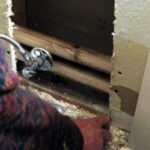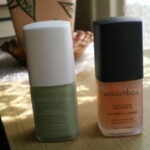Once you’ve got your room properly prepped and ready to go, you’re probably ready to just get that color on the walls. Be patient though, there’s still one more step. Application of primer is key to ensuring a good finish and color to your walls once you apply the color. Primer is used for many reasons when painting a fresh surface or repainting. If you’re working on a fresh drywall, or an are that has been repaired with vinyl spackle, Primer is required as paint will not stick to an unpainted/unprimed surface. The paint will quickly peel and crack when it dries. You can directly paint over another surface that has already been painted without using Primer, but primer helps protect your fresh paint by sealing in any stains as well as covering up large color contrasts. Such as painting over a very bright or very dark color with a neutral or light color like gray or white.
You’ll want to gather the appropriate tools before you start
Drop cloths
Rollers
Painter poles for rollers
Brushes
Paint roller trays
Primer
Ladder
Make sure your drop cloths are down and you’ve properly prepped the room before attempting to prime the walls for paint. If you still have furniture and other items in the room, cover them with drop cloths or plastic drop tarps to protect them.
If you’re going to apply even coats of primer over the entire wall to seal everything, pour your Primer (I always use Kilz) into a paint tray to the fill line. Dampen your roller just a little. Wring out as much of the excess as you can. This will help spread the primer more evenly. Remember to always start high and work your way down. This way, if you have drips, they will run into areas you haven’t yet painted.
Apply the primer from the roller in an up to down stroke, then fan out from left to right in an area about 3′ X 3′, spreading evenly. Continue this process down the wall, then move up and begin a new section. Use this same process to prime the ceiling, in 3′ X 3′ squares. This will ensure an even coat of primer. Coating all the walls and ceiling completely isn’t always necessary, but is highly recommended, especially if you’re applying a different color. Sometimes you can simply prime the areas you’ve repaired, particularly if you’re going to applying a new coat of the same color that’s already on the wall. You must at least prime any area you’ve patched with vinyl spackle, as the paint will not set on spackle.
Generally one coat of primer is all that is necessary, however I always took the time to apply a second coat. This would ensure a good seal of stains or color from underneath. Highly recommended if you’re painting over a dark or very bright color. Most stores that sell paint also have a station where they will mix color for you. You can have your primer tinted slightly with the color you’re going to paint with. This will help deepen the color you’ll be using, and lessens the need for additional coats of paint in the end.
Apply your first coat, using the brushes for corners. Be careful of leaving “ropes”. These are trails of paint left from the edge of the roller. I like to go back over areas I used with a brush, the edges and such, to make an even finish in the primer. Different tools leave different texture in the primer and paint. Brushes leave brush strokes that can be visible lines in your finished coat. Rollers leave stipple, like blotching. If you’ve rolled most of your walls, you can achieve and even finish by using the roller to go over areas where you’ve used a brush.
Let your primer coat dry for several hours. Return and check your work for thin spots where old color may show though. If you find drips or ropes that would effect your finished coat you can sand them down with a fine grade paper and apply a touchup coat of primer to that spot
Once your Primer coats are complete, you’re ready to setup and begin applying your new color.







